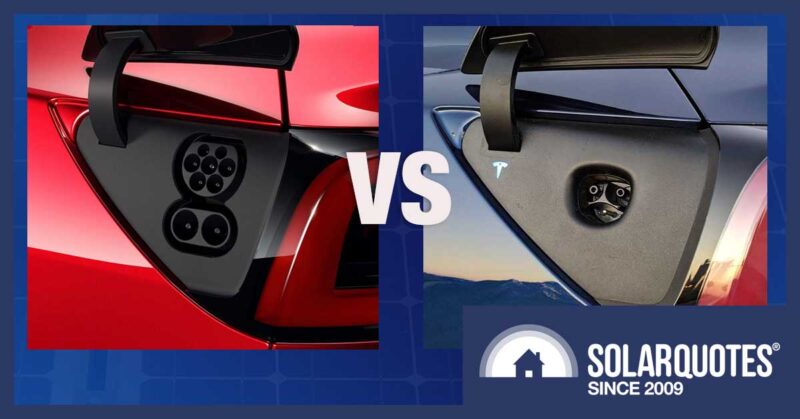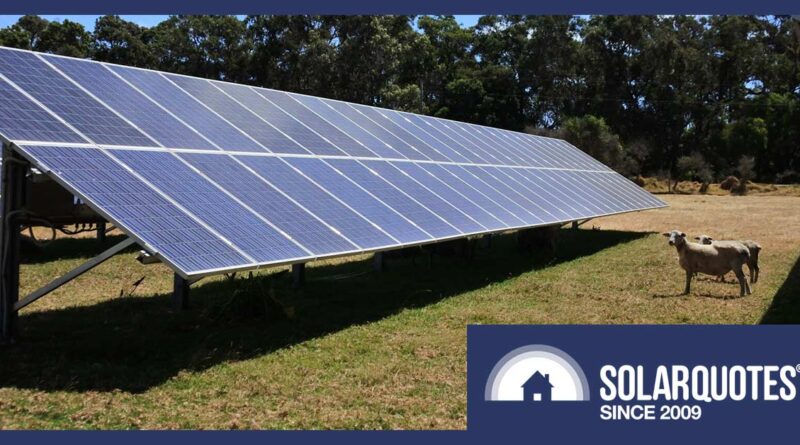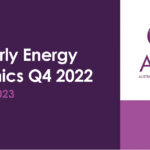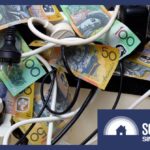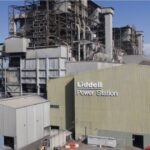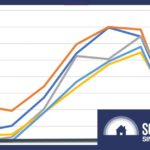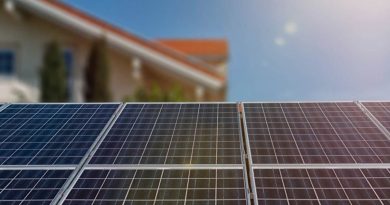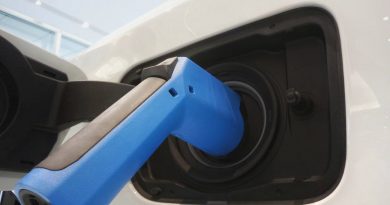If Renewables Are So Cheap, Why Is South Australian Electricity So Expensive?
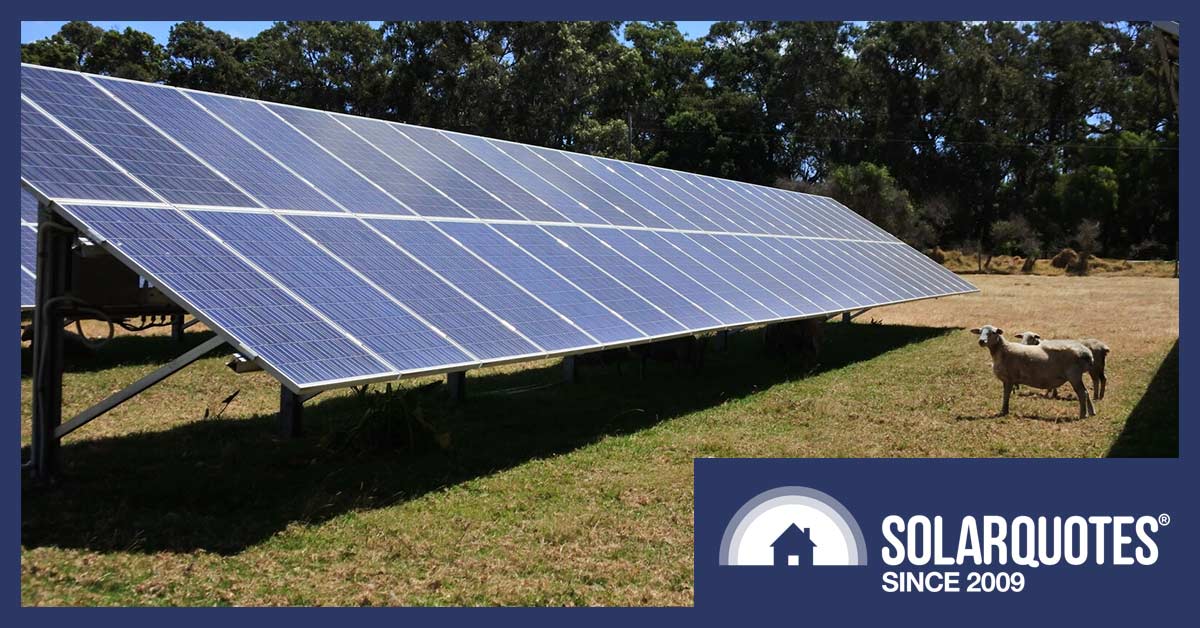
Recently I wrote about South Australia going from zero to 70% renewable energy generation in 16 years, resulting in:
- reduced greenhouse gas emissions
- improved air quality
- lower electricity prices than we’d have without those renewables
But – although our electricity prices would be much higher without renewable energy, electricity prices – overall – have still trended up over those 16 years. And that’s because many things affect electricity pricing.
A lack of competition is one factor pushing up prices, but the main influence is the rising cost of natural gas. Its price began to increase in 2015, recently reaching record highs. The cause of the recent increase was a decision made in Moscow. This decision affected us because we decided to expose most of Australia to international gas prices. That decision is all on us1.
Since the closure of the state’s last coal power station in 2016, natural gas has provided almost 99% of South Australia’s non-renewable generation. Last year it provided just under one-third of the electricity generated in the state. Because gas is a very flexible form of generation, it often acts as a price setter and, thanks to the way Australia’s wholesale electricity markets work, increases in the cost of gas tend to push up prices paid to all generation. This applies even if the generation cost of other sources decreases.
South Australia’s rapid increase in renewable capacity has helped limit the increase in its electricity prices. It’s easy to see it is helping when you look at this graph. See how often wind and solar power have supplied more electricity than the state consumes over a spring week:
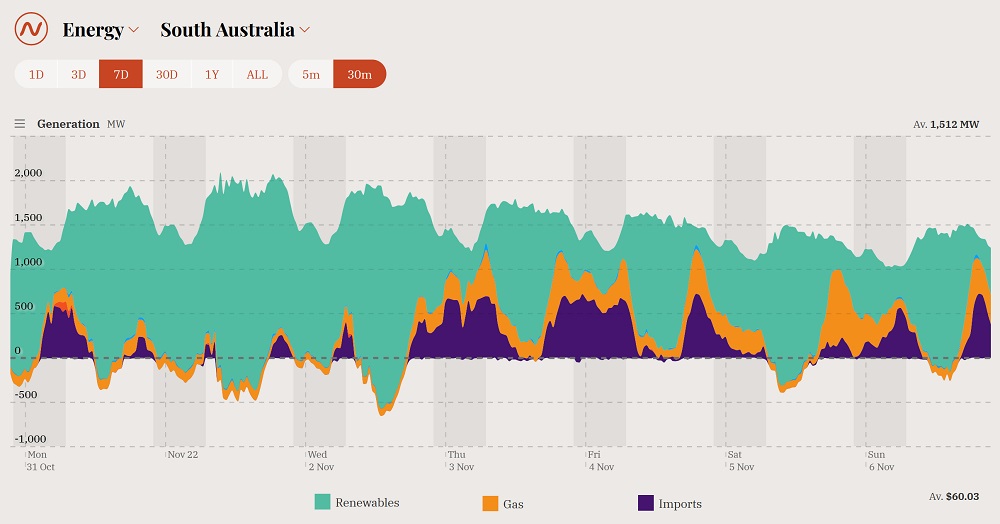
This graph is from OpenNEM. The blueish-green represents wind and solar energy generation, and when it falls below the dotted line, it supplies more electricity than the state consumes. (The surplus is exported to Victoria to help them catch up to how awesome SA is.) During these periods, wholesale electricity prices are normally either low, zero, or negative.
When renewables supply more electricity than the state needs, gas generators can’t normally set the price and prices can fall very low or go negative.
Below, I’ll use inflation-adjusted figures to show what happened with South Australia’s wholesale electricity prices as renewable energy generation increased. Then I’ll do the same for the state’s gas prices and show how they have an oversized effect on wholesale electricity costs.
Renewable Energy Should Lower Prices
South Australia’s renewable generation percentage has grown faster than anywhere else I can think of:
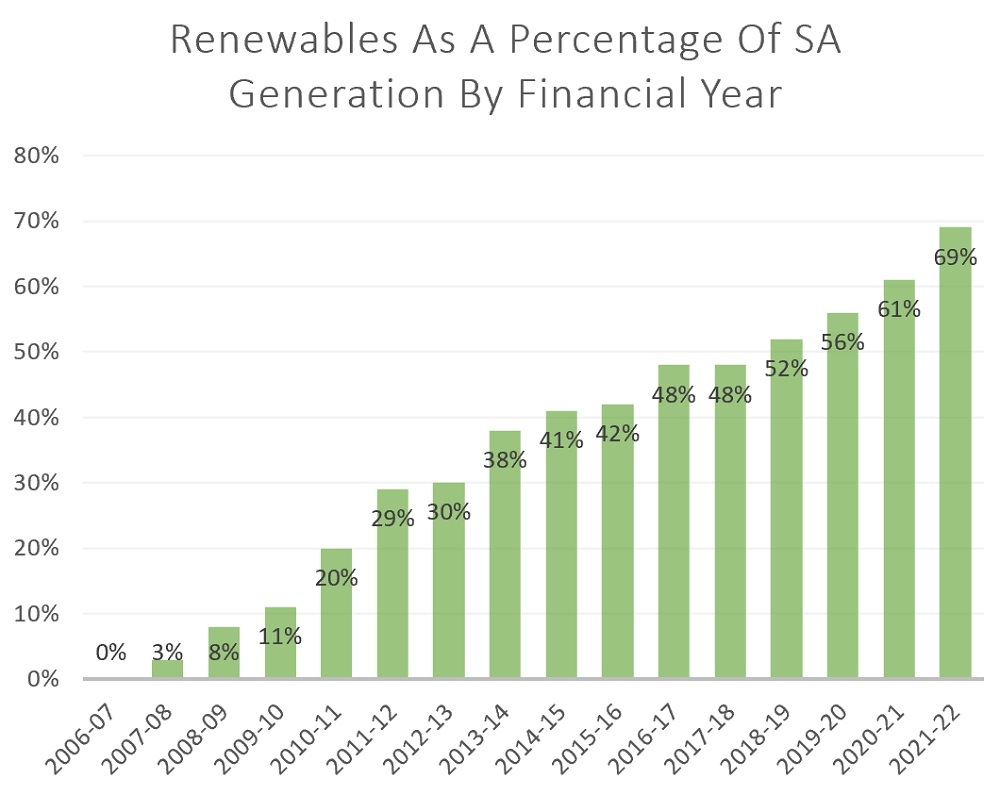
On our electricity bills, we pay a wide range of costs that include transmission, distribution, and retailing. But I’m just going to focus on the wholesale price of electricity2, which is what generators are paid for the electricity they provide to the grid.
Wind and solar generation lowers the average price of wholesale electricity in three main ways:
- Zero fuel cost: they will accept — or bid in — a lower price for electricity than fossil fuel generators that have to pay for fuel.
- Lower cost: new renewables, including energy storage, is now cheaper to build and operate than new fossil fuel generation.
- Increased Competition.
But the wholesale price of electricity depends on what else is going on in the electricity market.
Prices Look Like They’ve Gone Up
Here’s a graph kindly provided by the Australian Energy Regulator (AER) of average wholesale electricity prices in the National Electricity Market or NEM.
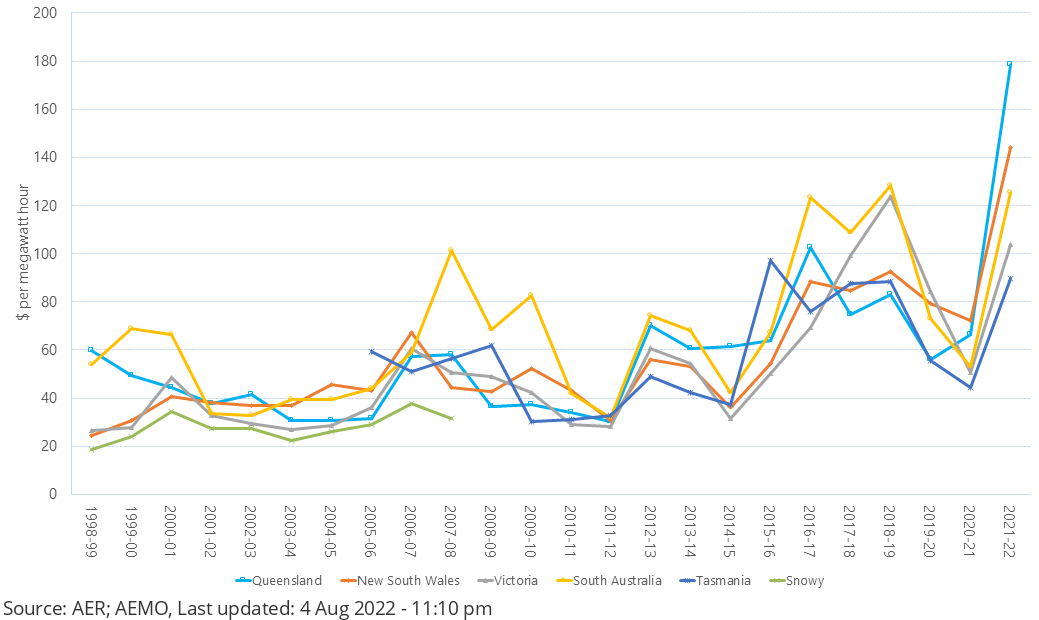
This is, technically, a graph of “Annual volume weighted annual 30-minute prices by region”. But we can call it “average wholesale electricity prices” just so long as no one tells the AER. Prices are given in dollars per megawatt-hour. For cents per kilowatt-hour, divide the dollar figure by 10.
As you can see, even ignoring the insane increases this year, South Australia’s wholesale electricity prices — the yellow line — have, overall, headed up as renewable energy capacity has increased.
But this does not take into account inflation.
The 5.4 cents per kilowatt-hour in the 1998-99 financial year is around 9.8 cents in today’s money, which is quite a difference. So I’ll make a graph of inflation-adjusted SA prices. Adjusting for inflation doesn’t mean prices haven’t gone up, but you will be able to see how much they have gone up in today’s money.
Adjusting For Inflation
I will use the AER’s figures for SA average wholesale prices but adjust them for inflation. I am going to round the wholesale prices to a tenth of a cent, which introduces a small inaccuracy. But I’m willing to put up with that if you are. After all, my therapist tells me I should be easier on myself.

After adjusting for inflation, SA’s average wholesale electricity price over the past 24 financial years looks like this:
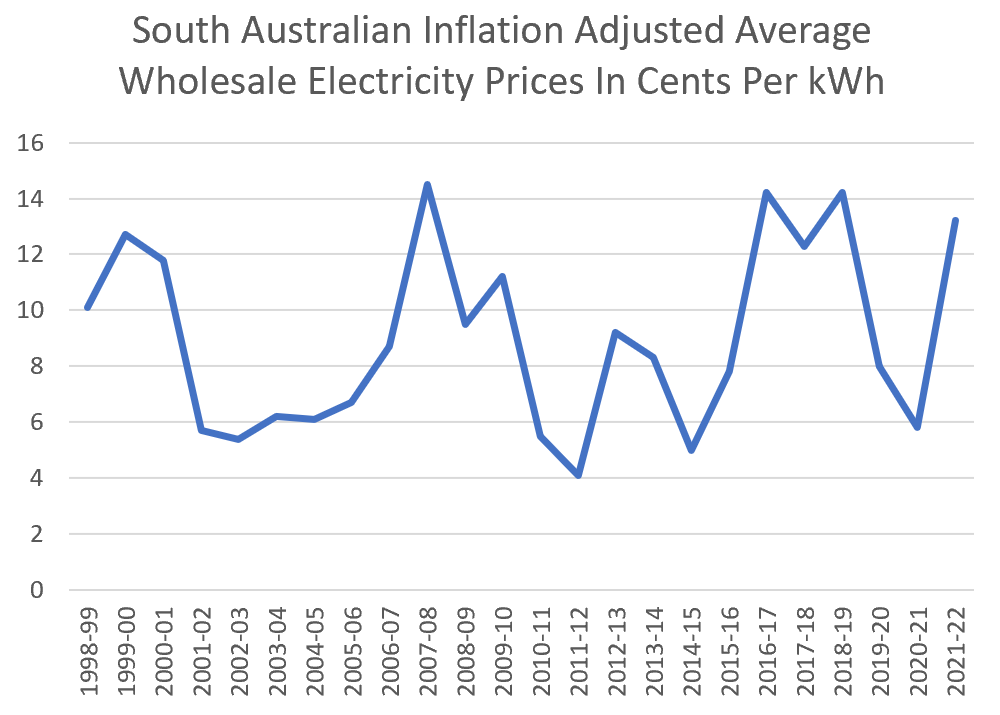
If I combine this with the earlier graph showing renewable energy generation at 0% in the 2007-08 financial year and going all the way to 69% renewables last financial year, it looks like this:
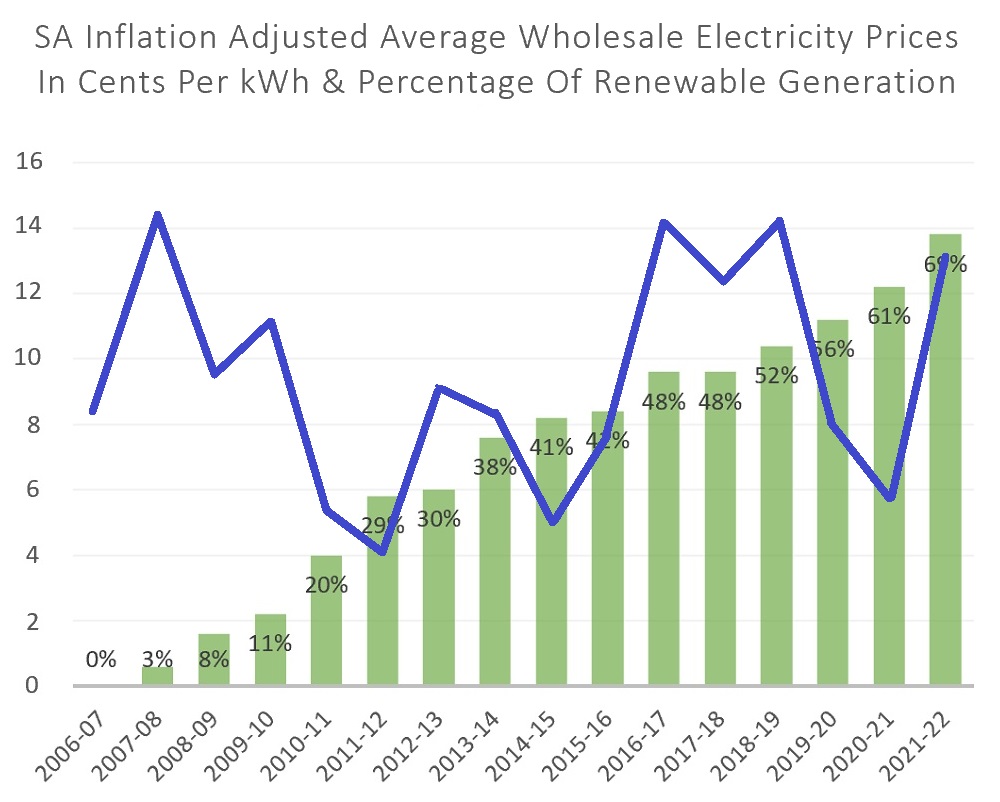
The average inflation-adjusted wholesale price for the first eight years is 7.8 cents. The average price of wholesale electricity over the next eight years was 10.1 cents. This makes it look like wholesale electricity prices have gone up as renewable energy production in South Australia has grown.
The reason it looks this way is because they have.
But this does not mean expanding renewable generation raised electricity costs.
Gas Prices Are Way Up
Here’s a graph of natural gas prices from the AER. This time South Australia3 is represented by the green line for Adelaide. As you can see, natural gas prices haven’t just risen; recently they’ve been “Bang! Zoom! Straight to the moon!“:
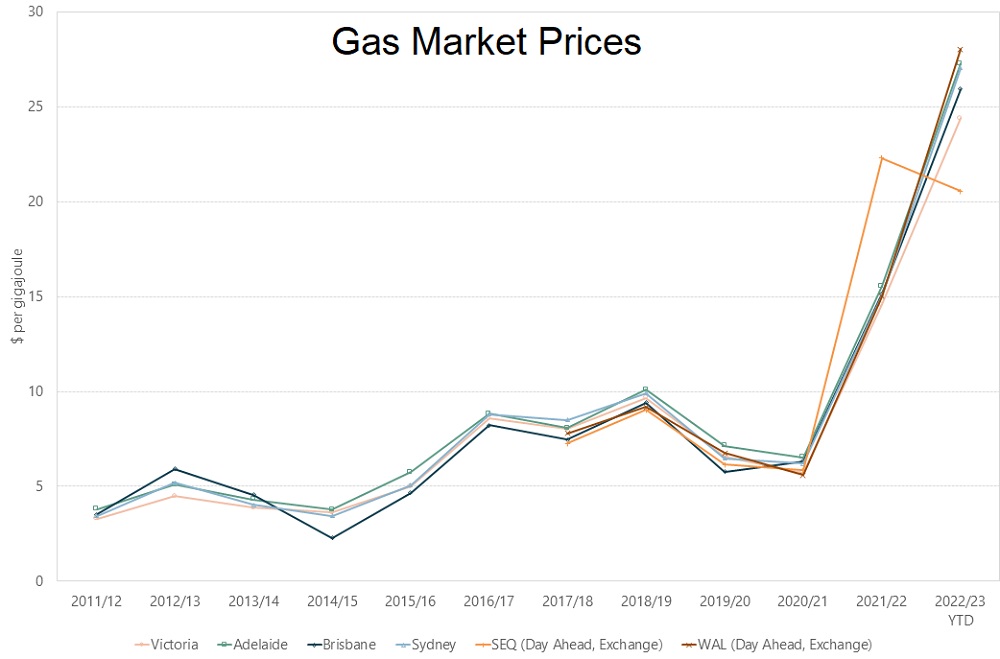
(Graph: AER)
If I adjust the AER figures for inflation and put them on the same graph as wholesale electricity prices, I get this:
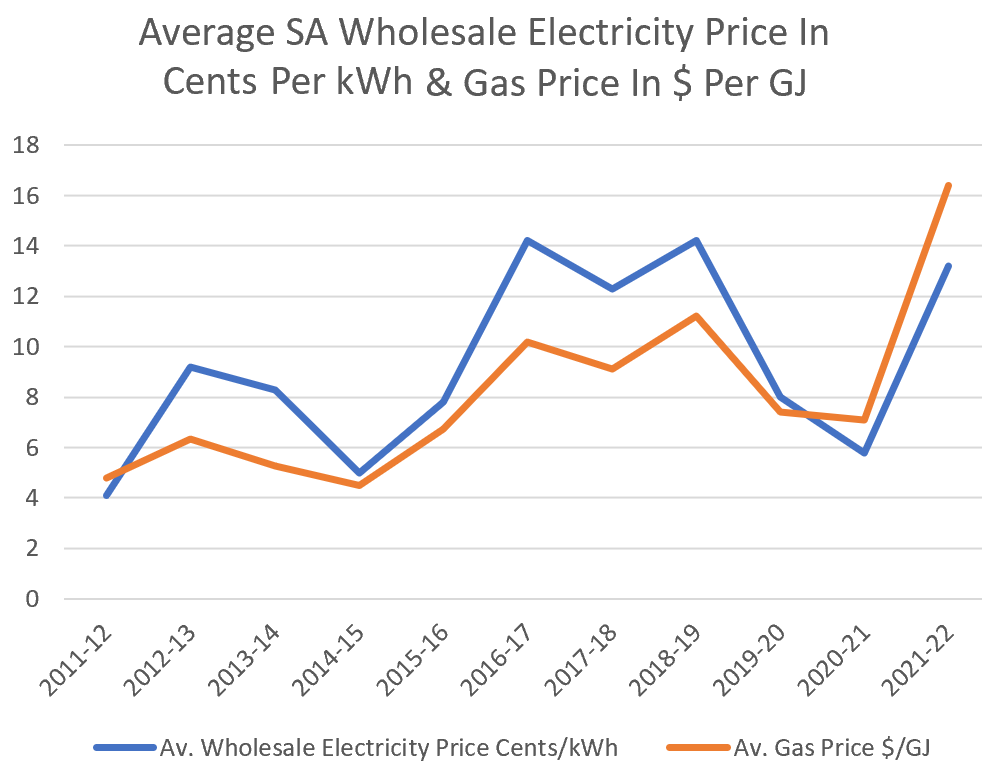
As the graph shows, the price of wholesale electricity and gas are highly correlated.
For the 12 years shown on the graph, state electricity generation from gas has ranged from 52.6% in 2017-18 to 29% in 2021-22. Because gas turbines are easy to start and stop, gas plays an outsized role in setting electricity prices. This means rises and falls in the cost of gas have a far stronger effect on wholesale electricity prices than the percentage of electricity gas generates.
Getting Off Gas
South Australia is rapidly reducing the amount of natural gas it uses to generate electricity, and the same is true for Australia. It’s simply too expensive compared to renewables plus energy storage.
The ability of gas to set prices will decrease as renewable energy capacity continues to expand, long-distance transmission capacity increases, and large amounts of battery storage become available. Victoria and Queensland have also committed to building large-scale pumped hydroelectric energy storage facilities, which will help when they — eventually — come online.
I also expect a natural gas glut in the future that will dramatically lower its price. The world is too uncertain a place to predict when this will happen, but my guess is it will happen sooner than most think.
Once gas is no longer a major influence, we will be in for a period of — hopefully — permanent low wholesale electricity prices and considerably lower electricity bills. Solar feed-in tariffs will also decrease, but you can’t have everything.
In the meantime, as long as wholesale electricity prices are high, it gives plenty of incentive to build more renewable capacity as well as energy storage. This means — in a roundabout way — high wholesale costs aren’t entirely bad. But I would have preferred to provide the incentive without transferring billions from consumers to fossil fuel generators.
Footnotes
- You could argue the responsibility is mostly on fossil fuel companies since that’s who politicians handed over most of their decision-making on the matter to, but I would argue it represents a lack of responsibility on behalf of our elected representatives.
- Specifically, I’m focusing on wholesale market prices. Wholesale electricity is also sold through contracts, but because their details are generally secret, I have to stick with using market costs.
- While not all of South Australia’s gas generation takes place around Adelaide, it’s still appropriate to use the Adelaide price.
Original Source: https://www.solarquotes.com.au/blog/cheap-renewables-expensive-electricity/

